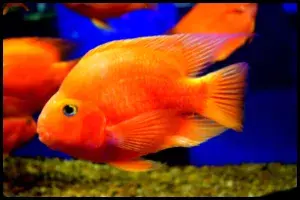
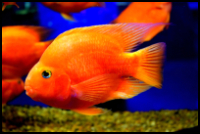
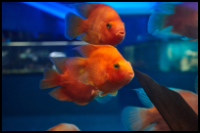
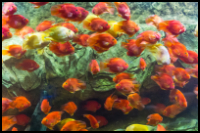

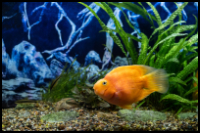
Quick Care Details (Table)
| Livestock Characteristics | Value |
|---|---|
| Care Level | Moderate |
| Temperament | Aggressive |
| Diet | Carnivore |
| Maximum Size | 8 Inches |
| Minimum Tank Size | 55 Gallons |
| Plant Safe | Yes |
| Temperature Range | 72-80F |
| PH Range | 6.5-8.0 |
| KH Range | 9-20 |
Species Specific Categories
Helpful Video
Care Details
Aquascape: Design your tank with plenty of hiding spots using rocks, caves, and driftwood for these playful fish to explore.
Substrate: Opt for a smooth substrate to prevent injuries, as their mouth structure is sensitive.
Disease Prevention: Maintain clean water through regular changes and quarantine new fish to prevent diseases.
Filtration: A strong filtration system is essential as these fish can be messy eaters and produce a lot of waste.
Lighting: Moderate lighting levels suit them best, not too bright or too dim.
Water Flow: Ensure gentle water flow as they prefer calm currents.
Hardiness: Blood Parrots are generally hardy but sensitive to poor water conditions.
Acclimation: Gradually acclimate them to any changes in water parameters to minimize stress.
Expected Lifespan: With proper care, they can live around 10-15 years.
Special Requirements: Due to their physical characteristics, they may display unique swimming behaviors.
document.getElementById("care-details-next-tab").addEventListener("click", function() {
document.getElementById("temperament-tab").click();
});
Temperament and Behavior
Behavior: Blood Parrots are curious and playful, often exploring their tank environment.
Breeding: Breeding Blood Parrots can be challenging due to their hybrid nature.
Aggression: They can exhibit aggression, especially during breeding or territorial disputes.
Tankmates Compatibility: Peaceful fish of similar size are suitable tankmates; avoid aggressive species.
Activity Level: Generally active swimmers, especially when comfortable in their environment.
Schooling or Shoaling Behavior: They aren't shoaling fish but may appreciate the company of their own kind.
Plant Compatibility: Expect them to rearrange plants due to their digging habits.
document.getElementById("temperament-next-tab").addEventListener("click", function() {
document.getElementById("diet-tab").click();
});
document.getElementById("temperament-previous-tab").addEventListener("click", function() {
document.getElementById("care-details-tab").click();
});
Diet and Nutrition
Dry Foods: High-quality pellets or flakes serve as a staple diet.
Frozen Foods: They enjoy occasional treats like frozen brine shrimp or bloodworms.
Live Foods: Offer live foods such as small insects or worms as an occasional treat.
Vegetables: Supplement their diet with blanched vegetables like zucchini or spinach.
Algae: While they might nibble on algae, it shouldn't be their primary food source.
Feeding Schedule: Feed them small portions 2-3 times a day to prevent overeating.
Supplemental Foods: Occasionally offer foods rich in carotenoids for their vibrant coloration.
document.getElementById("diet-previous-tab").addEventListener("click", function() {
document.getElementById("temperament-tab").click();
});
document.getElementById("diet-next-tab").addEventListener("click", function() {
document.getElementById("tank-parameters-tab").click();
});
Tank Parameters
Tank Size: Aim for a minimum of 50 gallons for a single Blood Parrot, larger for a group.
Tank Length and Measurements: Provide ample horizontal space for swimming.
Water Temperature: Maintain temperatures around 78-82°F (25-28°C).
pH (Acidity/Alkalinity): Aim for a pH around 6.5-7.5.
KH (Carbonate Hardness) and GH (General Hardness): Keep within acceptable ranges, around 5-15 dKH and 6-20 dGH, respectively.
Nitrate (NO3) levels: Maintain nitrate levels below 20 ppm through regular water changes.
document.getElementById("tank-parameters-previous-tab").addEventListener("click", function() {
document.getElementById("diet-tab").click();
});
History, Popularity, History and Species Variety Details
The History, Popularity and Natural Habitat
History: The Blood Red Parrot is a hybrid cichlid fish, believed to be a crossbreed between the Midas Cichlid (Amphilophus citrinellus) and the Redhead Cichlid (Paraneetroplus synspilus) or another related species. Its origins trace back to Taiwan in the late 20th century. Initially, these fish were selectively bred to achieve their distinct appearance, which includes their vibrant red coloration and unique body shape.
Popularity: Blood Red Parrots gained popularity among aquarium enthusiasts due to their striking colors, playful demeanor, and unusual appearance. Despite debates on ethical breeding practices due to their unnatural shape, they've captured the interest of many fishkeepers worldwide. Their captivating hues and friendly behavior make them stand out in aquarium displays, contributing to their widespread popularity.
Natural Habitat: In their natural environment, the Blood Red Parrot's ancestors, such as the Midas Cichlid, originated from Central America and are primarily found in rivers and lakes across regions like Nicaragua and Costa Rica. These areas typically consist of slow-moving or still waters with sandy or muddy substrates, along with abundant vegetation and hiding spots among rocks and driftwood.
Back to topSimilar fish species and variations
When considering variations and similar species to the Blood Red Parrot, it's important to note that due to their hybrid nature, they often have similarities in terms of physical traits, but variations can occur in coloration, patterning, and even slight changes in body structure. Here are some examples:
- Red Parrots: These variations encompass a wide range of hues within the red spectrum. Some might have deeper crimson shades, while others could display lighter or more vibrant reds. Additionally, some Red Parrots might exhibit patterns or patches of different colors within their red base, creating a unique and eye-catching appearance.
- Blood Red Cichlids: This category might consist of specimens with particularly intense red coloration, possibly with minimal patterning, resulting in a striking, solid red appearance. These variants often capture attention due to their vivid and uniform coloring.
- Red Devil Cichlids: While not identical, Red Devil Cichlids share a similar origin and often showcase vivid red coloration. They tend to have a more elongated body structure than Blood Red Parrots, featuring red hues blended with other colors such as orange or yellow, presenting a fiery appearance.
- Jellybean Parrots: This hybrid variation combines traits from different cichlid species. They might possess rounded body shapes akin to Blood Red Parrots but showcase a broader array of colors, including reds, oranges, and yellows, resembling the hues found in jellybeans.
- King Kong Parrots: This variation might have a larger body size, often exhibiting vibrant reds alongside patches of white or lighter tones. The coloration might resemble the vividness seen in Blood Red Parrots but with contrasting patches or spots.
Good Tank Mates For Your Blood Parrot Cichlid
- Angelfish: These elegant fish can coexist with Blood Parrots, especially in larger tanks. However, monitor their interactions as Angelfish can become territorial as they mature.
- Keyhole Cichlids: Relatively peaceful and similar in size, making them potential tank mates for Blood Parrots.
- Geophagus Cichlids: Some species within the Geophagus genus, like the Red Head Tapajos, are generally peaceful and can thrive alongside Blood Parrots in a spacious tank.
- Silver Arowana: In very large tanks, Silver Arowanas can coexist due to their upper-level swimming and peaceful nature, but their massive size requires a substantial tank.
- Firemouth Cichlids: These fish can sometimes be compatible due to their moderate temperament but provide adequate hiding spaces.
Back to top
Frequently Asked Questions
What makes Blood Red Parrots unique among cichlids?
These cichlid have vibrant red coloration and distinctive rounded body shape set them apart. They're hybrids with a fascinating mix of traits.
Are Blood Red Parrots suitable for community tanks?
Yes, Blood Parrot fish are generally peaceful and can coexist with non-aggressive tankmates of similar size, but monitor behavior to ensure compatibility.
What's their preferred tank setup?
Blood Parrot fish enjoy plenty of hiding spots, smooth substrates to avoid injury, and moderate lighting with gentle water flow.
How do I maintain Blood Parrot Cichlids vivid coloration?
Feeding Blood Parrot fish High-quality foods rich in carotenoids and a well-balanced diet contribute to their vibrant hues.
Can Blood Red Parrots breed?
Blood Parrot Cichlids are hybrids and might struggle with successful breeding. It's often challenging to rear the fry if breeding occurs due to their hybrid nature.
Do they require special care compared to other cichlids?
Blood Parrot Cichlids have similar care requirements regarding water parameters but might need more consideration due to their unique physical traits.
How large do Blood Parrot Cichlids grow?
Blood Parrot fish can reach around 8-10 inches in length, depending on their environment and genetics.
Are there specific health concerns for Blood Red Parrots?
Your Blood Parrot Cichlid can be sensitive to poor water conditions, so regular maintenance and water quality checks are crucial.
What's the best way to introduce this cichlid to a new tank?
Blood Parrot Cichlids appreciate a slow acclimation to new water parameters, which helps reduce stress; observe them closely during this period.
Can I keep Blood Parrot fish with live plants?
These type of cichlid might rearrange plants due to their digging habits, so robustly rooted plants or artificial decorations could be better options.

